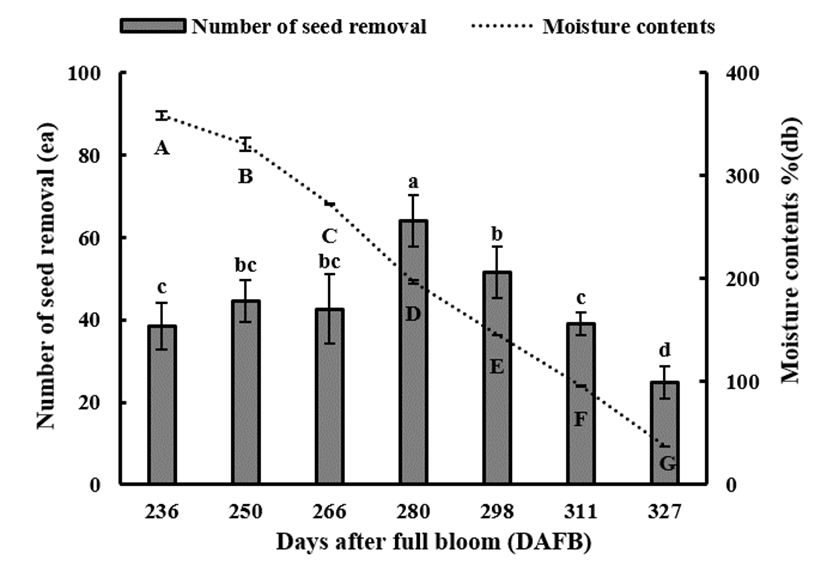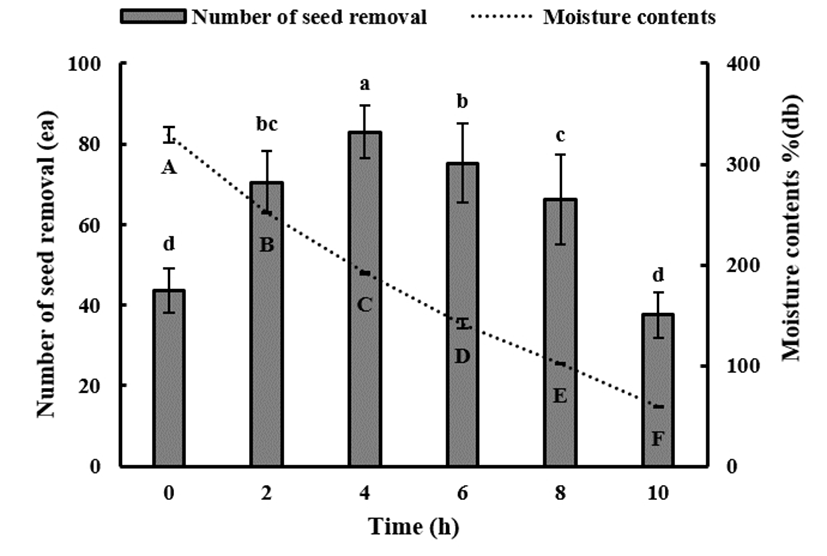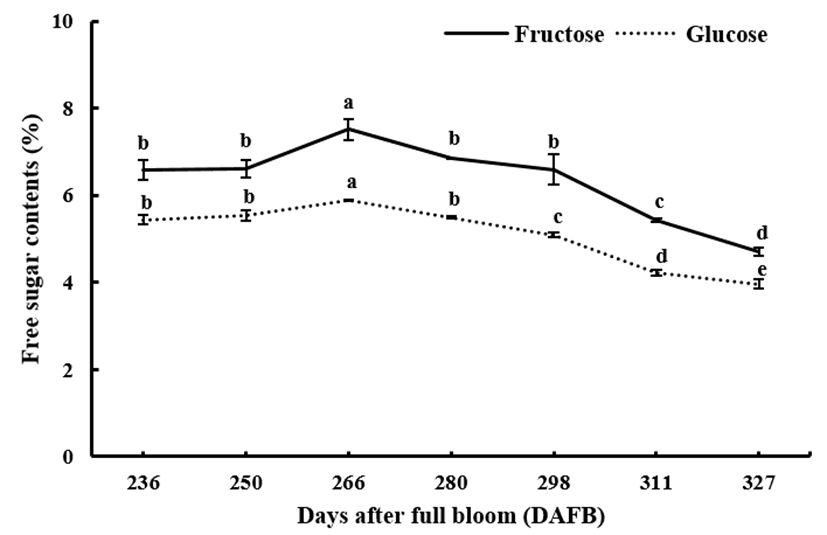서 론
산수유(Cornus officinalis)는 층층나무과(Comaceae)에 속하는 낙엽활엽소교목으로 3-4월에 노란 꽃이 개화하여, 10-11월에 붉은 열매를 맺는다(1). 산수유 열매(Corni Fructus)는 길이 10-15 mm, 너비 10 mm의 타원형이며, 윤이 나고 거친 주름이 있으며 어두운 적자색 외관이다(2). 산수유 열매의 종자는 단단하여 가공이 어렵고, 렉틴(lectin)이라는 성분이 있어 섭취 시 소화가 어렵다고 알려져 있다(3,4). 또한 핵과류에서 종자를 제거하지 않고 추출할 경우 추출시간이 길어지고 그 추출액의 탁도가 높아지는 단점이 있어(5), 산수유 열매의 종자를 제거한 후 과육을 건조하여 약용소재로 사용되고 있다(6). 산수유, 대추와 같은 약용식물을 제핵하는 방법은 블랜칭, 파쇄 후 선별, 기계에 의한 방법 등이 있으나(7), 농가에서는 아직까지 수작업에 의존하고 있다(8). 산수유의 성분으로는 gallic acid과 같은 유기산(9)과 glucose, fructose와 같은 유리당이 있으며(10), 또한 폴리페놀 및 플라보노이드가 풍부하여(11) 항산화성을 나타내는 주요성분으로 작용한다고 알려져 있다(12). 산수유 열매와 같은 약용소재는 채취 시기에 따라 pH, 당도, 산도 등과 같은 품질 특성의 변화가 민감하기 때문에 적정 채취 시기를 결정하는 것이 중요하다(13,14). 대추씨의 기계적 방법(8,15), 매실의 씨 분리 요인(16)과 기계적 제핵(17) 등이 보고되었으나, 산수유 열매의 제핵과 관련하여 채취 시기에 따른 연구는 현재까지 보고된 바 없다.
본 연구에서는 산수유 열매의 적정 채취 시기를 구명하기 위하여, 채취 시기 별로 제핵도와 유리당, 항산화능 및 색도 등의 이화학적 품질특성을 조사하여 보고하는 바이다.
재료 및 방법
본 실험에 사용된 산수유 열매(Corni Fructus)는 경북대학교(대구시 북구 산격동)에서 산수유 꽃의 만개일(days after full bloom, DAFB)로부터 열매가 성숙하여 수확이 가능한 236일에서 327일까지 약 15일 간격으로 7회에 걸쳐 채취하였다. 채취한 산수유 열매를 정선 및 수세하여 물기를 제거 후 제핵도의 실험에 사용하였다. 이를 동결건조하여 분쇄 후 표준체(Chung Gye Industrial Co., Gunpo, Korea)를 통과한 분말(>45 mesh)의 색도를 측정하였다. 산수유 분말과 90% ethanol을 1:10(w/v) 비율로 실온에서 3시간 추출하고 이를 여과하여 유리당, 항산화능의 분석용 시료로 사용하였다.
본 실험에서는 1,1-diphenyl-2-picrylhydrazyl(DPPH) (Sigma Chemical Co., St. Louis, MO, USA), potassium chloride(Junsei chemical Co., Ltd., Tokyo, Japan), sodium acetate(Shinyo Pure Chemicals Co., Ltd., Osaka, Japan)를 사용하였다. 건조는 동결건조기(MCFD8518, Ilsinbiobase, Dongducheon, Korea), 열풍건조기(CCDO-05, Cleanthermo, Siheung, Korea)를 사용하였다. 색도를 측정하기 위해 Hunter 색차계(CM-700d, Minolta Co., Osaka, Japan)를 사용하고, 항산화 활성과 항산화 함량을 분석하기 위해 UV/visible spectrometer(UV-1601, Shimadzu CO., Kyoto, Japan), microplate reader(Multiskan GO, Thermo Scientific, Waltham, MA, USA)를 사용하였다.
수분함량은 AOAC법(18)의 상압가열건조법을 이용하여 측정하고 건량(% dry basis)으로 나타내었다.
제핵도는 예비 실험을 통하여 숙련된 경북대학교 대학원생 5명이 5분 동안 제핵(3회)한 산수유의 평균 개수로 나타내었다.
유리당 함량은 high pressure liquid performance chromatography(HPLC)(1260 infinity quaternary LC system, Agilent technologies, Palo Alto, CA, USA)에 Zorbax-Carbohydrate analysis column(250×4.6 mm, 5 μm, Agilent Technologies), refractive index(RI) detector를 사용하여 분석하였다. 분석 조건으로는 컬럼온도 40℃, 주입량 20 μL, 이동상은 acetonitrile : water는 75:25 (v/v)의 비율, 그리고 flow rate는 1.4 mL/min로 분석하였다. 표준품은 fructose, glucose, maltose, sucrose(Sigma)를 사용하여 시료와 retention time을 비교하여 구한 검량선의 회귀식을 이용해 함량(%)을 산출하였다.
총 페놀성 화합물 함량은 Folin-Ciocalteau procedure 방법(19)을 변형하여 측정하였다. 분석용 시료 100 μL에 2 N Folin-Ciocalteau regent 50 μL와 20% sodium carbonate 300 μL를 가하여 실온에서 15분간 반응시켰다. 그 후 증류수 1 mL를 가하여 원심분리(1,250 rpm, 5 min)한 후 얻은 상등액을 725 nm에서 흡광도를 측정하였다. 총 페놀성 화합물 함량은 표준품 gallic acid를 사용하여 구한 검량선의 회귀식을 이용해 mg GAE/mL로 나타내었다.
총 안토시아닌 함량은 Lee 등의 방법(20)을 이용하여 측정하였다. 분석용 시료 0.5 mL에 0.025 M potassium chloride buffer(pH 1.0) 0.5 mL와 0.4 M sodium acetate buffer(pH 4.5) 0.5 mL를 각각 가하여 반응시켰다. 그 후 530 nm와 700 nm에서 흡광도를 각각 측정하였으며, 아래 식에 대입하여 계산하였다.
DPPH 라디칼 소거능은 Blois 등의 방법(21)을 변형한 방법으로 측정하였다. 분석용 시료 20 μL과 200 μM DPPH 시액 180 μL를 혼합한 후 30분간 암실에서 방치시킨다. 그 후 UV/visible spectrometer를 이용하여 517 nm에서 측정하였다. DPPH 라디칼 소거능은 표준품 gallic acid를 사용하여 구한 검량선의 회귀식을 이용해 mM GAE로 나타내었다.
결과 및 고찰
산수유 열매는 산수유 꽃의 만개일로부터 성숙하여 수확이 가능한 236일부터 327일까지 약 15일 간격으로 7회에 걸쳐 채취하였으며, 채취 시기에 따른 수분함량 및 제핵도는 Fig. 1에 나타내었다. 채취 시기가 늦어짐에 따라 산수유 열매의 수분함량은 358.91%(db)에서 37.47%(db)까지 감소하였다. 만개일로부터 280일에 채취한 산수유 열매의 제핵도가 64.08개로 가장 높았으며(p<0.05), 이때의 수분함량은 건량기준으로 197.40%(db)이었고 습량기준으로 66.00% (wb)이었다. 수분함량이 제핵도에 미치는 영향을 확인하기 위하여 50℃에서 2시간 간격으로 산수유 열매를 열풍건조하면서 수분함량 및 제핵도를 조사하여 Fig. 2에 나타내었다. 4시간째에 83.00개로 제핵도가 가장 높았고(p<0.05), 이때의 수분함량은 건량기준으로 191.90%(db), 습량기준으로는 65.74%(wb)이었다. 이는 산수유의 제핵도가 가장 높은 만개일로부터 280일에 채취한 시료의 수분함량인 66.00%(wb)와 거의 일치하였다. 산수유 열매의 제핵도와 수분함량은 밀접한 상관성이 있는 것으로 사료된다. 농가에서는 만개일로부터 280일 부근에 산수유 열매를 수확하거나, 수분함량 65-66%(wb)까지 건조하는 것이 제핵하기에 유리하다. 대추의 경우에도 건조하여 과육을 연화시키면 제핵이 용이하다고 보고(8) 된 바 있다.


채취 시기에 따른 산수유 열매의 유리당을 표준품으로 확인한 결과, glucose 및 fructose만 검출되어 정량하였다(Fig. 3). 산수유 열매의 fructose 함량은 4.70-7.52%, glucose 함량은 3.96-5.89%의 범위를 나타냈다. 산수유 추출물의 fructose 함량은 4.84%, glucose 함량은 4.18%로 보고된 연구결과와 비슷한 경향을 나타내었으며, 산수유 열매의 유리당은 glucose 및 fructose가 대부분이었다(10).

산수유 열매의 채취 시기에 따른 총 페놀성 화합물 함량, 총 안토시아닌 함량, DPPH 라디칼 소거능은 Table 1에 나타내었다. 산수유 열매의 채취 시기에 따른 총 페놀성 화합물 함량은 1.15-5.55 mg GAE/mL, 총 안토시아닌 함량은 18.03-66.82 mg/L, DPPH 라디칼 소거능은 5.12-15.48 mM GAE의 범위를 나타내었다. 총 페놀성 화합물 함량과 DPPH 라디칼 소거능은 채취 시기가 늦어지면서 감소하는 경향이었으며, 총 안토시아닌 함량은 만개일로부터 280일 이후에 감소하였다. 구기자도 수확시기가 늦어짐에 따라 총 페놀성 화합물 함량이 감소한다고 보고(22)된 바 있다.
Hunter 색차계를 이용하여 채취 시기별로 측정한 산수유 열매의 색도는 Table 2에 나타내었다. 색도는 명도(lightness), 적색도(redness), 황색도(yellowness)를 측정하였으며, 각각 35.37-54.50, 22.03-39.84, 15.68-23.42의 범위를 나타내었다. 적색도와 황색도는 만개일로부터 280일 이후에 감소하였으며, 이는 안토시아닌 함량의 변화와 유사한 경향이었다. 오미자 분말의 적색도가 높을수록 안토시아닌 함량이 높다고 보고(23)된 바 있다. 명도는 전반적으로 채취 시기가 늦어짐에 따라서 감소하는 경향이었다. 따라서 산수유의 채취 시기는 만개일로부터 280일 전후가 적정할 것으로 사료된다.
요 약
본 연구에서는 산수유 열매의 적정 채취 시기를 구명하기 위하여, 산수유 열매를 만개일로부터 수확이 가능한 236일에서 327일까지 15일 간격으로 채취하여 제핵도와 유리당, 항산화능 및 색도와 같은 이화학적 품질 특성을 조사하였다. 산수유 열매의 제핵도는 만개일로부터 280일에 가장 높았고(p<0.05), 이때 수분함량은 건량기준으로 197.40% (db), 습량기준으로 66.00%(wb)이었다. 산수유 열매를 열풍건조(50℃)하면서 제핵도와 수분함량을 측정하였으며, 유사한 수분함량 191.90%(db), 65.74%(wb)에서 제핵도가 가장 높았다(p<0.05). 산수유 열매의 유리당은 fructose와 glucose가 검출되었고, 만개일로부터 280일 지나면서 그 함량이 감소하는 경향을 보였다. 총 페놀성 화합물 함량과 DPPH 라디칼 소거능은 채취 시기가 지나면서 감소하는 경향이었으며, 총 안토시아닌 함량은 만개일로부터 280일 이후 감소하였다. Hunter 색차계로 측정한 산수유 분말의 적색도와 황색도는 만개일로부터 280일 이후에 감소하였으며, 명도는 전반적으로 감소하였다. 따라서 산수유 열매의 적정 채취 시기는 만개일로부터 280일이라고 사료된다.
